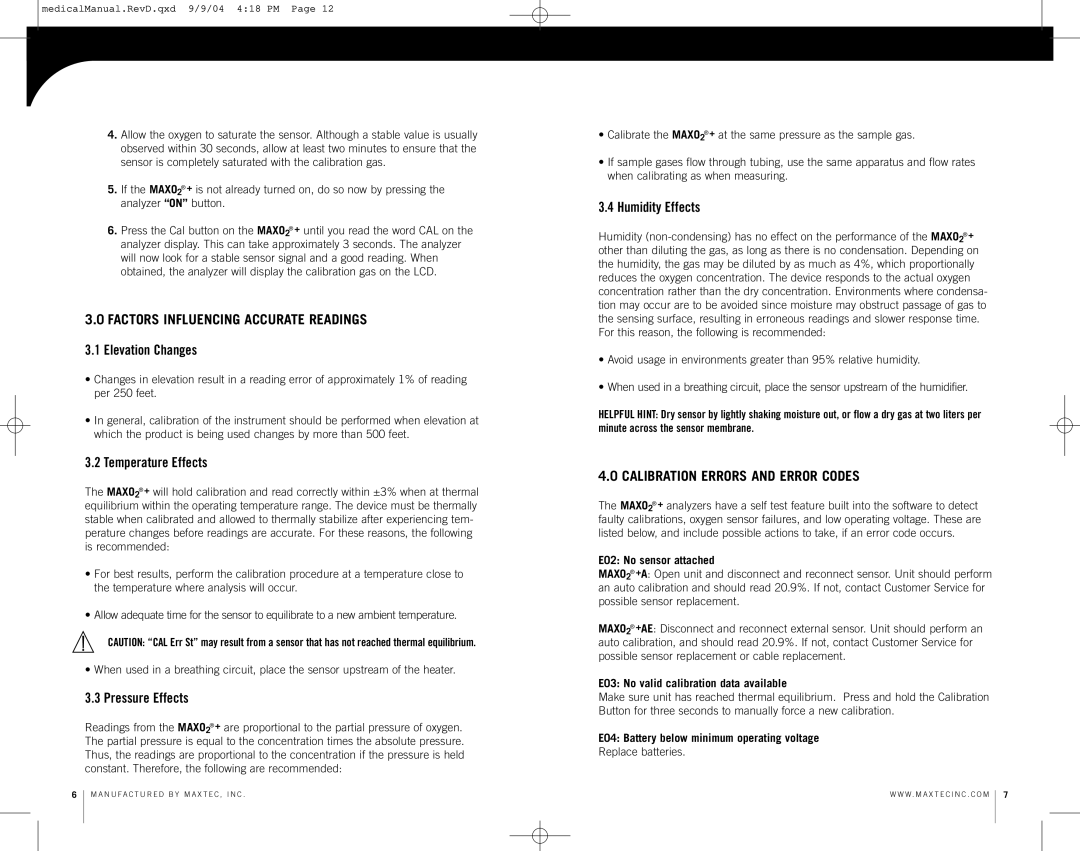
medicalManual.RevD.qxd 9/9/04 4:18 PM Page 12
4.Allow the oxygen to saturate the sensor. Although a stable value is usually observed within 30 seconds, allow at least two minutes to ensure that the sensor is completely saturated with the calibration gas.
5.If the MAXO2® + is not already turned on, do so now by pressing the analyzer “ON” button.
6.Press the Cal button on the MAXO2® + until you read the word CAL on the analyzer display. This can take approximately 3 seconds. The analyzer will now look for a stable sensor signal and a good reading. When obtained, the analyzer will display the calibration gas on the LCD.
3.0FACTORS INFLUENCING ACCURATE READINGS
3.1Elevation Changes
•Changes in elevation result in a reading error of approximately 1% of reading per 250 feet.
•In general, calibration of the instrument should be performed when elevation at which the product is being used changes by more than 500 feet.
3.2 Temperature Effects
The MAXO2® + will hold calibration and read correctly within ±3% when at thermal equilibrium within the operating temperature range. The device must be thermally stable when calibrated and allowed to thermally stabilize after experiencing tem- perature changes before readings are accurate. For these reasons, the following is recommended:
•For best results, perform the calibration procedure at a temperature close to the temperature where analysis will occur.
•Allow adequate time for the sensor to equilibrate to a new ambient temperature.
CAUTION: “CAL Err St” may result from a sensor that has not reached thermal equilibrium.
• When used in a breathing circuit, place the sensor upstream of the heater.
3.3 Pressure Effects
Readings from the MAXO2® + are proportional to the partial pressure of oxygen. The partial pressure is equal to the concentration times the absolute pressure. Thus, the readings are proportional to the concentration if the pressure is held constant. Therefore, the following are recommended:
•Calibrate the MAXO2® + at the same pressure as the sample gas.
•If sample gases flow through tubing, use the same apparatus and flow rates when calibrating as when measuring.
3.4 Humidity Effects
Humidity
•Avoid usage in environments greater than 95% relative humidity.
•When used in a breathing circuit, place the sensor upstream of the humidifier.
HELPFUL HINT: Dry sensor by lightly shaking moisture out, or flow a dry gas at two liters per minute across the sensor membrane.
4.0 CALIBRATION ERRORS AND ERROR CODES
The MAXO2® + analyzers have a self test feature built into the software to detect faulty calibrations, oxygen sensor failures, and low operating voltage. These are listed below, and include possible actions to take, if an error code occurs.
E02: No sensor attached
MAXO2® +A: Open unit and disconnect and reconnect sensor. Unit should perform an auto calibration and should read 20.9%. If not, contact Customer Service for possible sensor replacement.
MAXO2® +AE: Disconnect and reconnect external sensor. Unit should perform an auto calibration, and should read 20.9%. If not, contact Customer Service for possible sensor replacement or cable replacement.
E03: No valid calibration data available
Make sure unit has reached thermal equilibrium. Press and hold the Calibration Button for three seconds to manually force a new calibration.
E04: Battery below minimum operating voltage
Replace batteries.
6
M A N U FA C T U R E D B Y M A X T E C , I N C . | W W W. M A X T E C I N C . C O M |
7
